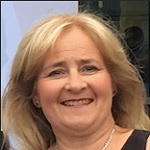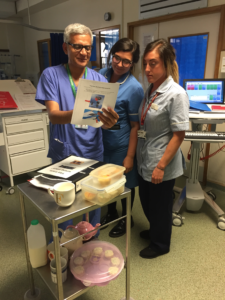How does an anaesthetist for a busy vascular surgery operating list combine the day job with time for training and time for tea breaks? What if anaesthesia colleagues paired up and one offered training and tea in the anaesthetic room, while the other covered her/him in theatre for ten minutes.
This was the logic behind Bath tea trolley training—a method of multidisciplinary training in the workplace during the normal working day (or night).
A trolley is loaded with educational materials on top and a pot of tea (and maybe cake) on the bottom, and now our anaesthesia team has time for training and tea breaks without jeopardising patient care or delaying theatre lists.
It complements existing training and prevents skill decay. For example, by running tea trolley training sessions in addition to regular training sessions we can reach staff who were unable to attend regular sessions as well as offer reminders, practice, and follow up to those who did attend.
It has been tried in other departments too. From teaching sessions on airway rescue techniques and maternal sepsis, to acute kidney injury and hypoglycaemia, it has proved very successful—analysis of 710 feedback forms indicates that after receiving tea trolley training 98% of staff have felt more confident in one or more of the aspects that were covered. Since we started in 2014, more than 1000 members of staff in our hospital have been taught using this method. And it works as well for student nurses as it does for professors.
This teaching technique has potential in many settings including anaesthetic rooms, wards, emergency departments, outpatient departments, GP surgeries, and administration areas. It can be adapted to suit different learning and teaching styles (visual, auditory, verbal, physical, one-on-one, group), grades of participants, and previous levels of experience.
Trainers include junior doctors, senior doctors, senior nurses, midwives, sepsis nurses, pharmacists and other allied health professionals. Typically, trainers spend one afternoon (when ward rounds are completed and operating lists are well underway) training and work with 20-30 people in that time. For consultant trainers, this can be part of their supporting professional activities (SPA) time. Juniors often come in on their days off and use their sessions as trainers as evidence for teaching sections of future job applications. Many of our junior doctors have felt so inspired that they take the idea to other hospitals when they rotate.
We have faced only a few challenges—namely for anaesthesia training sessions where it is always necessary for one of the trainers to be a senior registrar or above so they are able to provide appropriate cover in theatre; however, this is not an issue on the wards. While this training method has been universally popular with staff another problem has been keeping up with demand.
So far, we have received positive feedback from 18 other UK hospitals that have used the method, as well as from hospitals in France, Canada, and Australia. There are several reasons why this idea has spread so quickly: word of mouth from rotating trainees, our publications in Anaesthesia and Resuscitation, presentation at national conferences, and recommendations by the Royal College of Anaesthetists. [1,2,3,4]
Bath tea trolley training is simple, cheap, and works throughout the hospital. It is a training method that anyone could put into practice in their place of work (hospital or any other healthcare setting) within a week.
#bathteatrolley
 Lesley Jordan is a consultant anaesthetist at the Royal United Hospitals Bath NHS Foundation Trust, and Patient Safety Lead for the hospital.
Lesley Jordan is a consultant anaesthetist at the Royal United Hospitals Bath NHS Foundation Trust, and Patient Safety Lead for the hospital.
 Melanie McDonald is a consultant anaesthetist at the Royal United Hospitals Bath NHS Foundation Trust, and College Tutor for the anaesthetic department.
Melanie McDonald is a consultant anaesthetist at the Royal United Hospitals Bath NHS Foundation Trust, and College Tutor for the anaesthetic department.
Fiona Kelly is a consultant in anaesthesia and intensive care medicine at the Royal United Hospitals Bath NHS Foundation Trust, and Airway Lead for the hospital.
Competing interests: The ‘Bath Tea Trolley’ team were highly commended for their entry to the Education Team of the Year section of the BMJ awards 2018.
References
- O’Farrell G, McDonald M, Kelly FE. ‘Tea trolley’ difficult airway training. Anaesthesia 2014; 70(1): 104.
- Penketh J, McDonald M, Kelly FE. EZ-IO® intraosseous access teaching in the workplace using a mobile ‘tea trolley’ training method. Resuscitation 2015; 99: e17-8
- Kerton MCS, Gough C, Jones A, Hardy R, Kelly FE. Paediatric Anaphylaxis Management: training staff to actually draw up the correct dose of adrenaline. British Journal of Anaesthesia 2018; 120(4): 881–882
- Riley E, Payne S, Robinson O, Baruah R, Jones J, Cook TM< Kelly FE. ‘Trachy Tracey’: a novel education tool for tracheostomy training. Anaesthesia 2018, in press.


